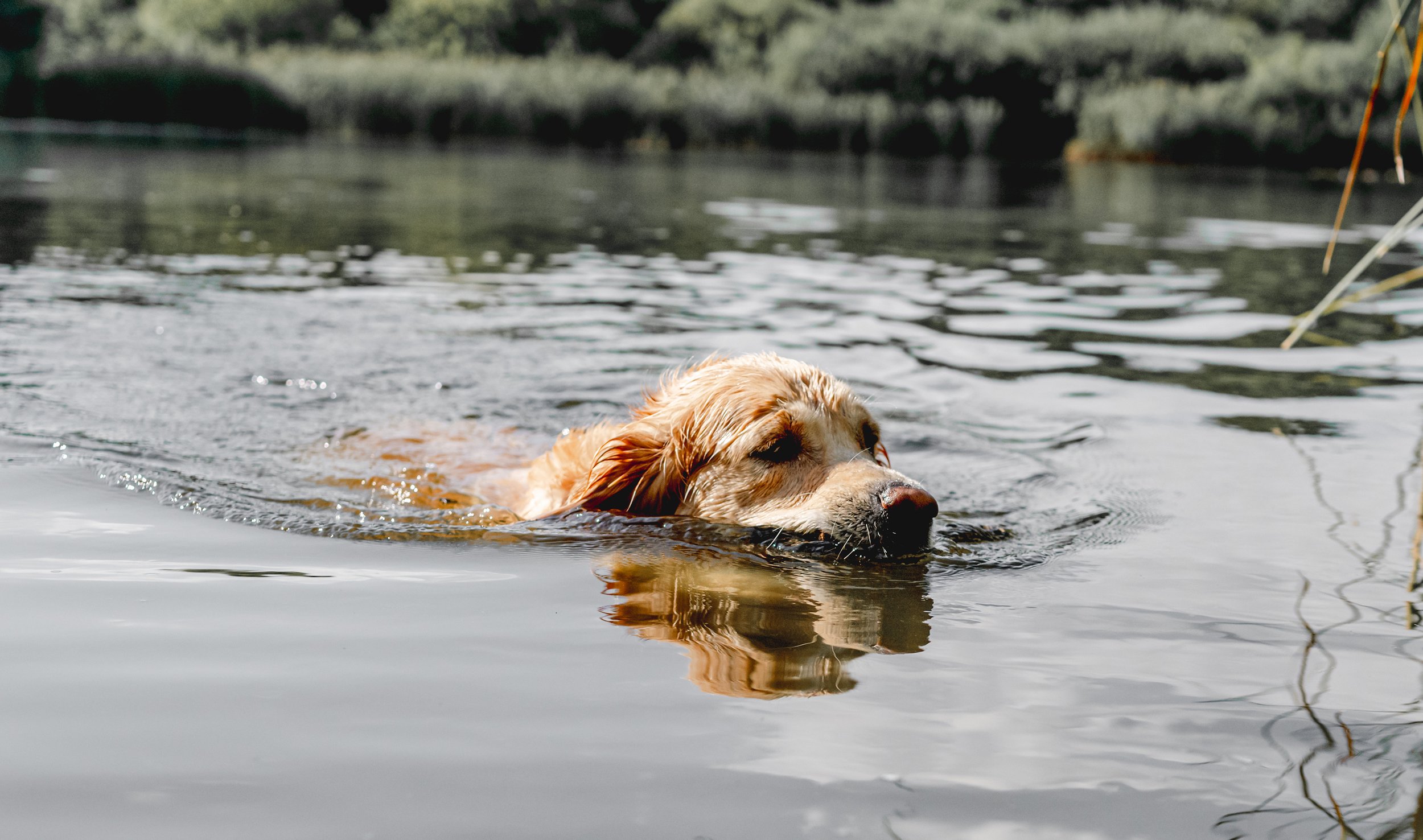Safe dog swimming
-
Flea and tick treatments for dogs contain chemical pesticides to kill fleas and ticks. But they can also kill similar creatures that naturally live in rivers, lakes and ponds. This resource will help you know what you can do to minimise harm to the environment.
-
Flea and tick treatments such as spot-ons or collars are used to control parasites on dogs. They work because they contain chemical pesticides that kill insects and ticks on your pets, but the chemicals are also poisonous to insects and tick-like creatures in the environment. The problem is that these chemicals can wash off treated dogs and pollute any water they go in, such as ponds, lakes and rivers (and even bath water).
If a lot of dogs treated with the chemicals swim in the same place, large amounts of pesticides can be washed off.
Some of the chemicals such as imidacloprid and fipronil - which are found in many common flea and tick treatments - have been shown to have severe negative effects on aquatic insects. Many British rivers and lakes already have levels of these chemicals that are much higher than those considered environmentally safe. And there is evidence that pond life is reduced in water that is contaminated by them.
Not enough is known about this environmental threat. Safety testing of these products has focused so far on ensuring the products are safe for pets, not the environment. But we do know that the national dog population – now over 10 million – is growing, and with it the use of flea and tick products. And we do know that our UK insect population is in dangerous decline, threatened by many factors including pesticides. This makes it sensible, and urgent, to try to reduce potential environmental damage caused by flea and tick products.
-
1.After you have applied a spot-on or collar (topical treatments) to your dog, DO NOT allow your dog to swim in water for at least the amount of time recommended by the manufacturer in the package leaflet that comes with the product. This is when the highest levels of pesticide will be present on the dog.
2. For most spot-ons, the manufacturer’s recommended gap before going in water is at least 2 days (48 hours) after treatment. For Bravecto, it is after at least 3 days. For Advocate, it is after 4 days. For Selehold and Stronghold, the manufacturer recommends waiting at least 2 hours before allowing a dog to swim. These time gaps are the minimum: published research shows that they may wash off from the dog for much longer than these suggested periods.
3. If your dog wears a flea or tick collar, follow the manufacturer’s advice about swimming and bathing. The advice is different for different collars, so follow the advice for the specific collar your dog wears.
4. Do not allow your dog to swim in locations where dogs are prohibited.
5. If your dog swims regularly, consider avoiding spot-ons and collars. Use tablets instead. Your vet can prescribe flea and tick treatments in the form of tablets and there are now effective products you can buy without a veterinary prescription. They are Advantage Chewable tablets for dogs (containing the pesticide lotilaner) and Frontpro chewable tablets for dogs (containing the pesticide afoxolaner). These kill fleas within a few hours and remain effective against fleas and ticks for 1 month. As the pesticide in these tablets leaves the dog’s body mainly in the poo, bagging and binning the poo of dogs treated with these products is important to protect the environment. Tablets available without a prescription that contain nitenpyram only effectively kill fleas, not ticks and their effect is not long-lasting enough to prevent further infestation.
If you no longer have the package that your product came in, you can look up the product information in the Veterinary Medicines Directorate’s (VMD’s) product information database
The VMD advises pet owners “Do not allow animals recently treated with topical medicines to enter streams, rivers or other water courses, as these medicines can be fatal to water life.”
-
When to use flea and tick treatments
Effective flea and tick treatments can help to keep dogs healthy when parasites are causing a health problem. But there is a growing trend towards using these treatments on most dogs against all common parasites all year round. With the dog population also growing, this will increase the amount of pesticide ending up in the environment. In response, the British Veterinary Association has said that vets should do individual risk-assessments on dogs to assess the need for parasite treatment instead of routinely treating every dog all year round. (There is more about this in the British Veterinary Association’s information on responsible use of parasiticides for cats and dogs). If your dog does not need regular parasite treatment, this approach will save you money as well as preventing unnecessary chemicals from entering the environment.
What are the different types of flea and tick treatments?
There are more than a 100 different brands of flea and tick products for dogs on the market in the UK. Each brand contains one or more pesticide ingredients. The products are available as spot-ons, sprays, shampoos, collars, tablets and injection.
Some products can be bought from any retailer, including online (without professional advice), some can only be bought from outlets (including online) where there is a vet, pharmacist or a professional veterinary medicines advisor, and some can only be bought with a veterinary prescription (including online).
Spot-ons, collars and most of the tablets are designed to remain on or in the dog’s body for several weeks or months. This is so that they can prevent infestation with fleas or ticks over a long time (usually one month or 3 months depending on the product). Shampoos and certain tablets (those containing nitenpyram) only have an immediate killing effect and do not prevent further infestation.
How do parasiticides get into the environment?
It depends on the type of product. Research in this area is ongoing and understanding about what happens to these products after they have been applied to a dog is increasing.
There are two types of spot-on. Most spot-ons work against fleas and ticks by remaining on the dog’s skin and coat for several weeks. If the dog is washed or swims, some of the pesticide is likely to wash off, either down the drain or directly into waterways. Some will slowly be released into the household or wider environment through shed hair and skin or through direct transfer onto hands and textiles such as bedding. From there it may be washed into waterways via household waste water.
A few of the spot-on products work because the pesticides are absorbed across the skin into the dog’s blood circulation. The pesticide leaves the dog’s body, mainly in the dog’s poo and a small amount in the urine. Small amounts may enter hair and skin, and pass to the environment through this route
Questions to ask your vet or other professional supplier
Parasite treatments, like all veterinary and human treatments, should only be used when necessary. Talk to your vet, SQP (registered animal medicines advisor) or pharmacist about what parasite treatments are really necessary for your dog. Ask the following questions:
Why are you recommending a parasite product for my dog?
Does my dog have a history of fleas or ticks?
How likely is it that my dog will become infested?
What parasite product to treat or prevent fleas and ticks does my dog need?
Which type of product is most suitable for my dog? Say if your dog swims or is bathed often
How often should it be used?
How long does the product need to be used for?
Which product is least harmful to the environment?
About this information
This information resource has been prepared for dog owners in the UK. It has been written collaboratively by veterinary surgeons and environmental scientists. It is published by Veterinary Prescriber, a trusted independent provider of information on veterinary medicines to veterinary professionals.
Last updated 14 August 2025

